K O
B A
Y A
S H
I
A
K
I
R
A
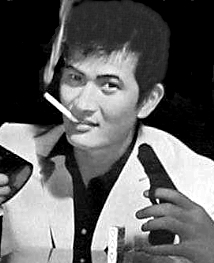
Name: Kobayashi Akira
Born: November 3, 1937
Birthplace: Tokyo, Japan
Key Nikkatsu films: Guitar o Motta Wataridori(1959),
Kaette kita Sempu-ji(1962), Kanto Mushuku (1963),
Ore ni Sawaru to Abunaize (1966).
Kobayashi Akira was Nikkatsu's #2 Action Man during their "diamond line" heyday (from 1959-1962, approximately). He was second only to the unbeatable Ishihara Yujiro. In contrast to the more flamboyant Yujiro, Akira specialized in characters that seemed slightly subdued; yet, that could (and usually would) erupt in an explosion of visceral action at any given moment. This prompted the Nikkatsu promotional squad to dub 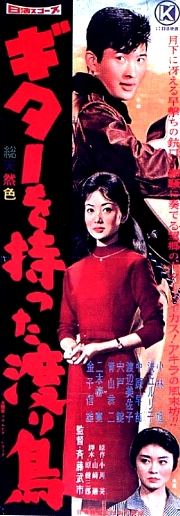 him, "Mr. Dynamite" (one poster of the era claiming, "You never know when he might go off!")! Suave, handsome, musically inclined, and athletic, Kobayashi was, if such a thing can be imagined, a Japanese cross of Erroll Flynn, Roy Rogers, and (James Bond-era) Sean Connery.
him, "Mr. Dynamite" (one poster of the era claiming, "You never know when he might go off!")! Suave, handsome, musically inclined, and athletic, Kobayashi was, if such a thing can be imagined, a Japanese cross of Erroll Flynn, Roy Rogers, and (James Bond-era) Sean Connery.
From an extremely early age, Akira wanted nothing but to be an actor. In 1944, he joined the Azuma Children's Theatre Company (the first of its kind in Japan). He was only 4 years old. He continued as a stage actor well into his High School years.
In 1954, Fate saw to it that Kobayashi accompanied the members of his theatre troupe on a tour of Nikkatsu Studios. During this visit, the strikingly handsome Akira so impressed producer, Shigeki Ryoji, that he was hired as an actor immediately. Though excited at the prospect of performing in films, the young film buff, Akira, also knew the value of sticking with his school work, too. Thus, he appeared in only a few Nikkatsu films, as an uncredited extra, until after he graduated from High School.
Kobayashi doesn't recall his film debut; but, he does recall his feelings upon seeing himself, for the first time, on the big screen. He felt extremely excited, thrilled, and at the same time humble. He could not believe that he was watching himself on the screens of movie houses where he had spent many happy hours watching the perfomances and antics of his favorite screen idols (among them, American actors Erroll Flynn and John Wayne). This impression was so great, Akira decided that there was no other life for him than that of a Movie Star!
Upon his graduation from High School, in 1955, he flung himself headlong into acting. His commitment to a successful career in show business was deep. He worked very hard to sharpen his acting skills, determined to rise above the standard studio player status he had achieved. Nikkatsu felt confident in his abilities, as well, and they began grooming him to be a matinee idol. All efforts paid off when, in 1956, Nikkatsu officially named him one of their "Third Group of Nikkatsu New Faces" (a group which also included the
great Nitani Hideaki) and released his first major motion picture, "Ueru Tamashi"
("Hungry Spirits"), with fair success. However, Kobayashi didn't truly click with the
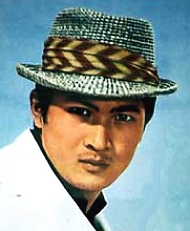 general movie-going public until 1959 and the release of "Nangoku Tosa o Ato ni Shite" ("Leaving Tosa Behind"). The stunning success of this picture made him an instant Nikkatsu superstar.
general movie-going public until 1959 and the release of "Nangoku Tosa o Ato ni Shite" ("Leaving Tosa Behind"). The stunning success of this picture made him an instant Nikkatsu superstar.
Some Nikkatsu Aciton fans call 1959, "The Year of Akira!", and not without good reason.
It was during this year that Kobayashi starred in many of his most successful, and fondly
remembered, films. The astoundingly popular "Wataridori" ("Wandering Guitarist"), "Nagaremono" ("Drifter" or "Vagabond"), and "Ginza Sempu-ji" ("Ginza Whirlwind") series were all spawned in this year. It is interesting to note that each one
of these film series consists of, at least, five or six films, and most of them were produced between the years of 1959 and 1963. A staggering number of films for such a brief peiod; but, business as usual for the Nikkatsu film factory!
The characters Kobayashi portrayed in these films--whether it was the guitar-strumming, singing adventurer of the "Wataridori" films, the drifting, thrill-seeking, gunman and gambler of the "Nagaremono" pictures, or the baton-wielding, tough, club bouncer of the "Ginza Sempu-ji" series--all seemed prone to shockingly sudden violence when unduly provoked. [It is a testament to Akira's great acting abilities to see him make the small, ineffective-looking, "police" baton seem like a powerfully lethal weapon in the "Ginza Sempu-ji" movies!] Akira's premeditated, well-rehearsed
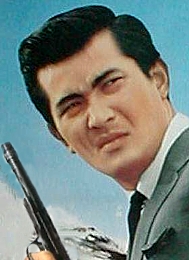 style of letting the tensions within his characters build until they explode (usually in cathartic violence) gave creedence to the "Dynamite" tag. Besides the numerous aciton films, Kobayashi Akira was also very adept and popular as a leading man in several romantic comedies.
style of letting the tensions within his characters build until they explode (usually in cathartic violence) gave creedence to the "Dynamite" tag. Besides the numerous aciton films, Kobayashi Akira was also very adept and popular as a leading man in several romantic comedies.
Throughout the 60's, Akira appeared in some of the finest examples of Nikkatsu Aciton cinema available. He is perfect as the stoic, sword-slinging, suke-attracting yakuza in Suzuki Seijun's delightful "ninkyo" attempt, "Kanto Mushuku" ("Kanto Wanderer"). He is equally impressive in Hasebe Yasuharu's wild "Ore ni Sawaru to Abunaize" (meaning, roughly, "It is Dangerous to Touch Me!", released on video in the US
as "Black Tight Killers"). This latter film--often called a tounge-in-cheek, pop-art, spy spoof, by current critics--is an extremely entertaining, slightly serious attempt, by Nikkatsu and Hasebe, to create an international-style, Bondian action flick.
After a tremendous number of successes with Nikkatsu, Kobayashi Akira left the studio in 1971. Akira, like nearly all of Nikkatsu's leading action players at the time, did not want to be associated with the new "Pink Eiga"-producing version of his parent studio.
He made one final film for the studio after announcing his resignation. It was a hard-boiled yakuza film, "Boryoku Dan: Nori Komi" ("Yakuza Marching In"), which was
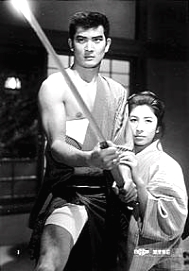 typical, in style and theme, of the few films he would go on to make with other studios (most notably Toei) throughout the 70's.
typical, in style and theme, of the few films he would go on to make with other studios (most notably Toei) throughout the 70's.
After leaving Nikkatsu, Kobayashi concentrated heavily on establishing himself as a popular Enka singer. His signature high-pitched voice was an interesting contrast to the deep, soulful tone of his former Nikkatsu colleague, Ishihara Yujiro, who was also achieving great success as an Enka singer at the same time. Akira's singing popularity peaked in the mid-to-late 1970's, although he remains active in this field (having recorded over 300 songs to date).
Since 1993, after performing in his 149th film, Kobayashi Akira has all but disappeared from the cinema. Perhaps, one day, if we can be so lucky, "Mr. Dynamite" will explode onscreen once again!
Profile by Chris Casey for Yaju no Yabai Gumi. 2001.
With special thanks to Tatsuya Fukushima!
Home->
 him, "Mr. Dynamite" (one poster of the era claiming, "You never know when he might go off!")! Suave, handsome, musically inclined, and athletic, Kobayashi was, if such a thing can be imagined, a Japanese cross of Erroll Flynn, Roy Rogers, and (James Bond-era) Sean Connery.
him, "Mr. Dynamite" (one poster of the era claiming, "You never know when he might go off!")! Suave, handsome, musically inclined, and athletic, Kobayashi was, if such a thing can be imagined, a Japanese cross of Erroll Flynn, Roy Rogers, and (James Bond-era) Sean Connery. 
 general movie-going public until 1959 and the release of "Nangoku Tosa o Ato ni Shite" ("Leaving Tosa Behind"). The stunning success of this picture made him an instant Nikkatsu superstar.
general movie-going public until 1959 and the release of "Nangoku Tosa o Ato ni Shite" ("Leaving Tosa Behind"). The stunning success of this picture made him an instant Nikkatsu superstar.
 style of letting the tensions within his characters build until they explode (usually in cathartic violence) gave creedence to the "Dynamite" tag. Besides the numerous aciton films, Kobayashi Akira was also very adept and popular as a leading man in several romantic comedies.
style of letting the tensions within his characters build until they explode (usually in cathartic violence) gave creedence to the "Dynamite" tag. Besides the numerous aciton films, Kobayashi Akira was also very adept and popular as a leading man in several romantic comedies. typical, in style and theme, of the few films he would go on to make with other studios (most notably Toei) throughout the 70's.
typical, in style and theme, of the few films he would go on to make with other studios (most notably Toei) throughout the 70's.